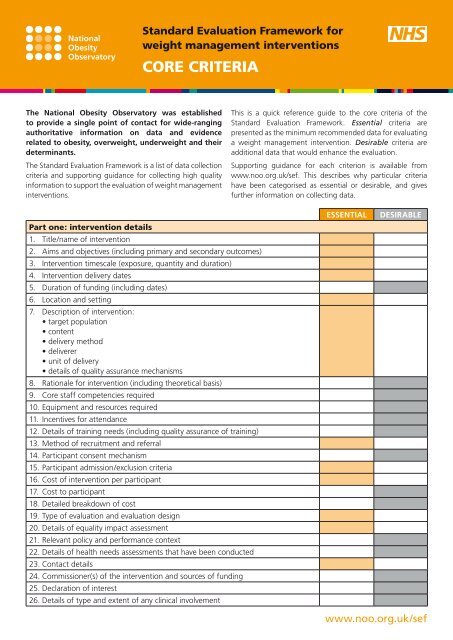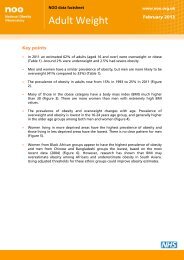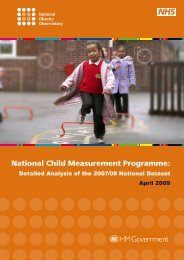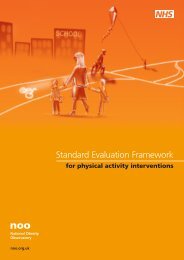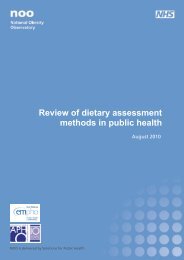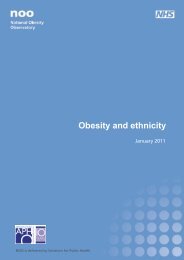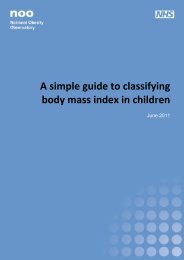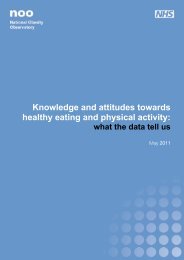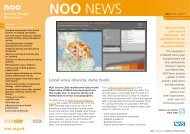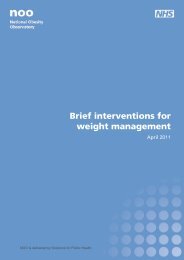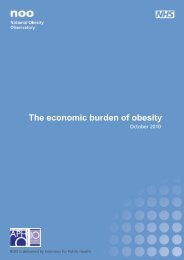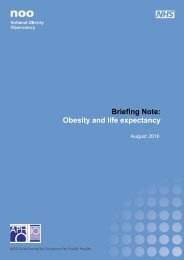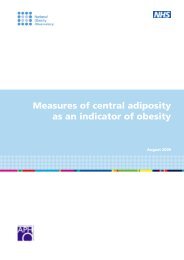CorE CritEria - National Obesity Observatory
CorE CritEria - National Obesity Observatory
CorE CritEria - National Obesity Observatory
Create successful ePaper yourself
Turn your PDF publications into a flip-book with our unique Google optimized e-Paper software.
Standard Evaluation Framework forweight management interventionsCore CriteriaThe <strong>National</strong> <strong>Obesity</strong> <strong>Observatory</strong> was establishedto provide a single point of contact for wide-rangingauthoritative information on data and evidencerelated to obesity, overweight, underweight and theirdeterminants.The Standard Evaluation Framework is a list of data collectioncriteria and supporting guidance for collecting high qualityinformation to support the evaluation of weight managementinterventions.This is a quick reference guide to the core criteria of theStandard Evaluation Framework. Essential criteria arepresented as the minimum recommended data for evaluatinga weight management intervention. Desirable criteria areadditional data that would enhance the evaluation.Supporting guidance for each criterion is available fromwww.noo.org.uk/sef. This describes why particular criteriahave been categorised as essential or desirable, and givesfurther information on collecting data.Part one: intervention details1. Title/name of intervention2. Aims and objectives (including primary and secondary outcomes)3. Intervention timescale (exposure, quantity and duration)4. Intervention delivery dates5. Duration of funding (including dates)6. Location and setting7. Description of intervention:• target population• content• delivery method• deliverer• unit of delivery• details of quality assurance mechanisms8. Rationale for intervention (including theoretical basis)9. Core staff competencies required10. Equipment and resources required11. Incentives for attendance12. Details of training needs (including quality assurance of training)13. Method of recruitment and referral14. Participant consent mechanism15. Participant admission/exclusion criteria16. Cost of intervention per participant17. Cost to participant18. Detailed breakdown of cost19. Type of evaluation and evaluation design20. Details of equality impact assessment21. Relevant policy and performance context22. Details of health needs assessments that have been conducted23. Contact details24. Commissioner(s) of the intervention and sources of funding25. Declaration of interest26. Details of type and extent of any clinical involvementESSENTIALDESIRABLEwww.noo.org.uk/sef
Standard Evaluation Framework for weight management interventions: Core CriteriaPart two: demographics of individual participants27. Age28. Sex29. Ethnicity30. Disability31. Measure of socio-economic status32. Additional information including marital status, medical history, smoking status,parity and family make-up33. Details of parental weight status (for children)Part three: baseline data34. Height and weight (to calculate Body Mass Index)35. Additional proxy measures for adiposity36. Measure(s) of dietary intake and behaviour37. Measure(s) of physical activity levels and behaviour38. Potential facilitators of, and barriers to, lifestyle changePart four: follow-up dataImpact evaluation39. Follow-up data: minimum of three follow-up points,including at one year40. Follow-up data on key measures (height, weight, physical activity and diet) overa greater term than one year41. Height and weight (to calculate Body Mass Index)42. Follow-up data on additional proxy measures for adiposity(if collected at baseline)43. Dietary intake and behaviour44. Physical activity levels and behaviour45. Follow-up measures on potential facilitators of, and barriers to, lifestyle change(if collected at baseline)Process evaluation46. Number invited47. Number recruited48. Number attended each session or contact point49. Number completed50. Number of participants at each follow-up point51. Methods of data collection and timings52. Reasons for opt-out (where applicable)53. Details of any unexpected outcomes and/or deviations from the intendedintervention design and the reasons why54. Participants’ satisfaction with the intervention55. Plans for sustainabilityPart five: analysis and interpretation56. Summary of results compared to baseline (for primary and secondary outcomes)57. Details of any further analyses and statistical methods used58. Limitations and generalisabilityESSENTIALDESIRABLEwww.noo.org.ukNOO is part of Supporting Public Healthseptember 09


